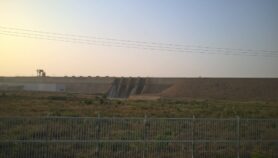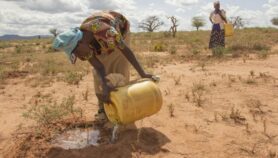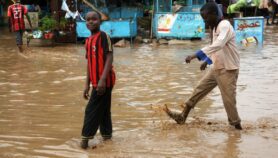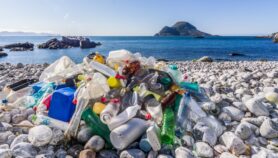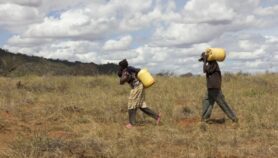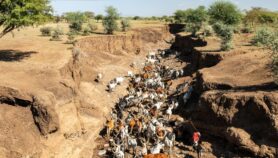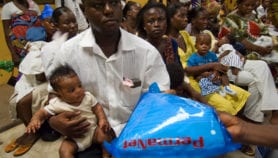By: Dann Okoth
Send to a friend
The details you provide on this page will not be used to send unsolicited email, and will not be sold to a 3rd party. See privacy policy.
[NAIROBI] Safe water supply is key to fighting the COVID-19 pandemic but access to this vital commodity remains elusive for millions of people living in Sub-Saharan Africa, reports say.
Water access gaps in Sub-Saharan Africa remain, both at institutions such as healthcare facilities and schools, and at the household level, endangering millions lives by the lack of simple hygiene practices such as handwashing.
According to Water.org, a non-profit organisation that aims to increase access to water and sanitation globally, 41 per cent of Kenyans do not have basic sanitation solutions while 15 per cent use unimproved water sources including ponds, shallow wells and rivers.

Unprotected rain-fed ponds provide source of water for people and animals. Copyright: UNICEF Ethiopia/Getachew
“Now more than ever, access to safe water is critical to the health of families so they can prepare and protect themselves from COVID-19 pandemic and other diseases,” says Patronilla Musonye, a project officer at the Kenya Water for Health Organisation (KWAHO), a non-profit organisation that promotes the right to access to safe water and health.
Healthcare facilities face water challenges
Less than half of all healthcare facilities in the Sub-Saharan Africa have basic water services, adds the 2020 Water, Sanitation and Hygiene (WASH) progress report, published by the World Health Organisation (WHO) and United Nations Children’s Fund through the WHO/UNICEF Joint Monitoring Programme (JMP).
“But the true extent of the problem remains hidden, due to persisting data gaps in many countries in the region,” says the report, which was published to coincide with the International Universal Health Coverage Day last year.
Samuel Godfrey, an advisor on WASH at the UNICEF’s Eastern and Southern Africa regional office, tells SciDev.Net that the pandemic, which forced poor populations into self-isolation, led to increased demand for urban water and sanitation systems, thereby compounding the WASH situation in Sub-Saharan Africa.



School students wash their hands before and after attending their classes using the washing basins provided by UNICEF to combat Covid 19. Photo Credit: UNICEFEthiopi/2020/NahomTesfaye
The latest report on WASH indicates how investing in WASH services in healthcare facilities is critical to recovery from the COVID-19 pandemic.
But Godfrey says, “We still do not know the full extent of the COVID-19 impact on WASH in the region because this is an evolving situation.”
Only 46 per cent of healthcare facilities in Sub-Saharan Africa have basic water services, against the global average of 76 per cent, according to the report. For example, the coverage of basic water services in healthcare facilities varied widely between countries in the region in 2019, with some surprising inter-country data.
Zimbabwe and Somalia, which have lower Gross Domestic Product (GDP) fared better on basic water services coverage in healthcare facilities recording 81 and 76 per cent respectively, against bigger economies such as Ethiopia and Nigeria, whose proportion of health care facilities with basic water services were 30 and 46 per cent respectively.
Godfrey explains that the disparities are informed by tax regimes, investment priorities and tariffs, adding that conflicts and climate change impacts also contribute to the disparities experienced in the region. “Lowest coverage levels in the Horn of Africa and highest coverage in southern Africa were due to conflict and climate impact,” Godfrey explains.
“We still do not know the full extent of the COVID-19 impact on WASH in the region because this is an evolving situation.”
Samuel Godfrey, UNICEF
The 2020 global report on WASH in healthcare facilities follows earlier ones published on households in 2017, schools in 2018 and healthcare facilities in 2019, and an updated one on schools in 2020.
In Sub-Saharan Africa, there were disparities in WASH coverage in healthcare facilities between urban and rural areas, with urban coverage being nine percentage points higher for basic water, 19 points higher for basic sanitation and 38 points higher for hygiene compared with rural coverage.
Schools lack basic water services
The latest WASH report on schools, which compares data on 2015 and 2019, also describes the implications for ensuring the safety of students and school staff during the COVID-19 pandemic.
In 2019, two-thirds of countries with less than 50 per cent coverage of drinking water in schools were in Sub-Saharan Africa, the report adds. For example, only 36 per cent of schools in Nigeria had basic water services, which is lower than the average for Sub-Saharan Africa: 44 per cent.
According to the report, at least 30 per cent of schools in Benin, Cameroon and Senegal had limited drinking water service. “Consequences for lack of basic water services go beyond just washing hands and quenching thirst,” Musonye says.
Adolescent girls missing school due to their periods is a growing phenomenon in Sub-Saharan Africa. The report cites the results of a survey of girls aged 15-24 years in West Africa showing that one in four girls in Nigeria, one in five in Côte d'Ivoire and one in seven in Burkina Faso missed school due to menstruation in the last 12 months.
“Clean water in health and learning institutions should be highly prioritised to aid disease reduction and improve health status of community members.”
Patronilla Musonye, Kenya Water for Health Organisation (KWAHO)
When in school, teachers and students may struggle to manage menstruation if toilets lack water to enable them wash and change when needed. In Nigeria, for instance 41 per cent of urban schools and just 14 per cent of rural schools had water and soap available for girls’ toilet compartment, the report notes.
Even fewer schools had covered bins in toilets and mechanisms for disposing of menstrual materials, but urban schools were twice as likely to have these facilities than rural schools.
According to the report, more than half of the 462 million children globally (244 million children) who lacked hygiene service at their schools in 2019 were in Sub-Saharan Africa but inadequate data to estimate the exact number of affected schools is a concern in countries of this region.
The report adds that most schools in high income countries have piped water supplies but the situation is different for countries in Sub-Saharan Africa where most schools use other types of improved sources including boreholes, rainwater or protected wells and spring.



Data provided by WHO/UNICEF, 2020. Illustration done by SciDev.Net SSA.
Communities across the region have had to device new ways to cope, as resources dwindled amidst the pandemic.
“Poor populations were unable to generate an income and could not pay for water tariffs,” Godfrey says. “Many countries introduced subsidies for water utilities and cash transfers to target vulnerable households.”
According to KWAHO, in rural Kenya, the average total coping cost for an unreliable or distant water supply is about US$38 per month.
In comparison, the average water bill of a typical household in the capital Nairobi, that is connected to a piped system is only US$4.46 per month.
“This comparison highlights the economic burdens that often fall more heavily on unconnected rural consumers than households with piped connections,” Musonye explains.
But there is hope, she says, as some of the healthcare facilities and schools that had no basic water services prior to the COVID-19 pandemic are now having access to such a basic resource.
“Clean water in health and learning institutions should be highly prioritised to aid disease reduction and improve health status of community members,” Musonye says.This piece was produced by SciDev.Net’s Sub-Saharan Africa English desk.






